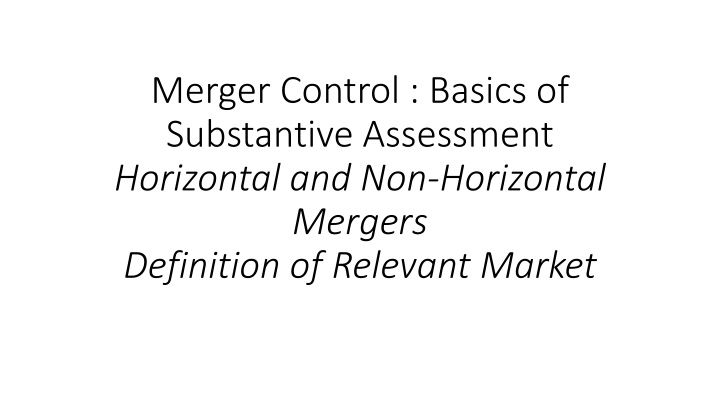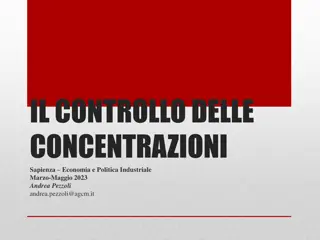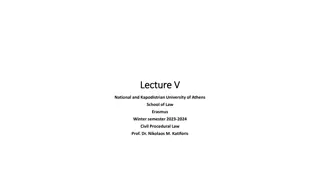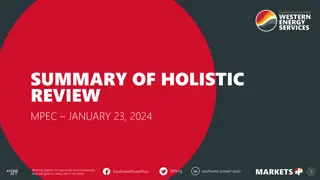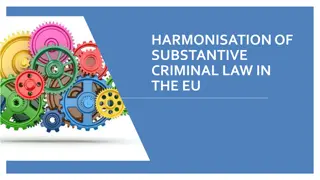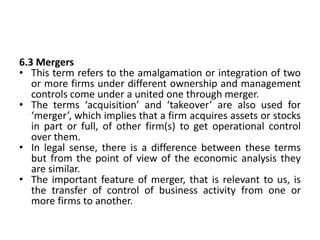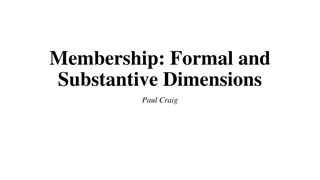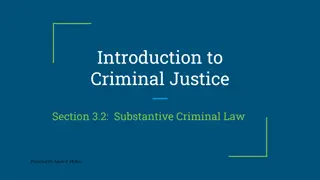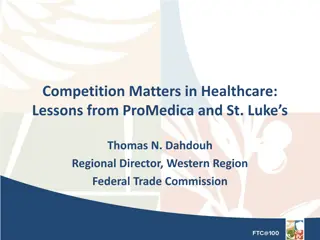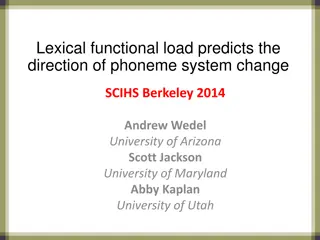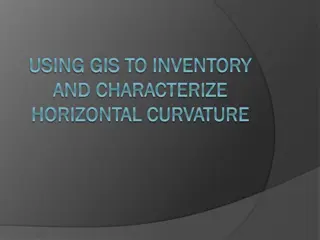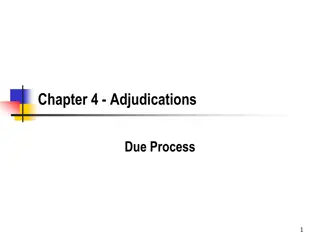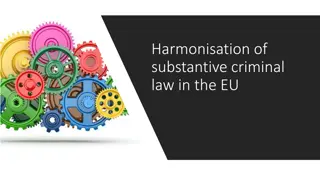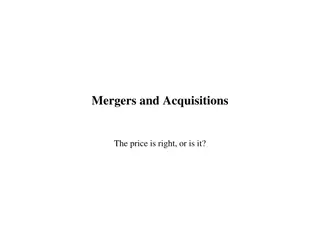Substantive Assessment of Mergers: Horizontal vs. Non-Horizontal
The substantive assessment of mergers involves evaluating whether a concentration significantly hinders effective competition. Horizontal mergers occur between undertakings in the same market, potentially reducing consumer choices. Non-horizontal mergers, such as vertical or conglomerate mergers, happen between undertakings in different market relationships. The European Commission provides guidelines for assessing both horizontal and non-horizontal mergers to determine their impact on competition.
Uploaded on Sep 21, 2024 | 4 Views
Download Presentation

Please find below an Image/Link to download the presentation.
The content on the website is provided AS IS for your information and personal use only. It may not be sold, licensed, or shared on other websites without obtaining consent from the author.If you encounter any issues during the download, it is possible that the publisher has removed the file from their server.
You are allowed to download the files provided on this website for personal or commercial use, subject to the condition that they are used lawfully. All files are the property of their respective owners.
The content on the website is provided AS IS for your information and personal use only. It may not be sold, licensed, or shared on other websites without obtaining consent from the author.
E N D
Presentation Transcript
Merger Control : Basics of Substantive Assessment Horizontal and Non-Horizontal Mergers Definition of Relevant Market
Provided that there is a concentration and that there is jurisdiction on part of the Commission, that institution is normally supposed to engage in a substantive assessment of a concentration at issue The substantive provisions for the Commission s assessment are found under Article 2(2) and (3) of the Merger Regulation Those read : 2. A concentration which would not significantly impede effective competition in the common market or in a substantial part of it, in particular as a result of the creation or strengthening of a dominant position, shall be declared compatible with the common market. 3. A concentration which would significantly impede effective competition, in the common market or in a substantial part of it, in particular as a result of the creation or strengthening of a dominant position, shall be declared incompatible with the common market.
The substantive assessment as to whether a concentration significantly impedes effective competition varies in regard to markets in relation to which the concentration occurs A concentration to be effected between, or in regard to, undertakings active on the same market is a horizontal merger (i.e. the undertakings concerned are on the same level of the market) As a general rule, horizontal mergers are thought to have potentially more anticompetitive potential than other mergers, because merging undertakings are active on the very same market, which leaves the consumers with fewer options to choose from Guidance from the Commission on horizontal mergers is found in Guidelines on the assessment of horizontal mergers under the Council Regulation on the control of concentrations between undertakings https://eur-lex.europa.eu/legal-content/EN/ALL/?uri=CELEX:52004XC0205(02)
On the other hand, mergers may occur in environments different than the horizontal relations between undertakings concerned Mergers may also be vertical (i.e. undertakings concerned are not active on the same market, but on different upstream and downstream markets, i.e. they are in a supplier-customer relationship Mergers may also be, according to the Commission, conglomerate , in that merging undertakings are neither horizontally nor vertically related; according to the Commission, this is in practice relevant for undertakings that are active on closely related markets e.g. mergers involving suppliers of complementary products or of products which belong to a range of products that is generally purchased by the same set of customers for the same end use Commission gave guidance on non-horizontal mergers in Guidelines on the assessment of non-horizontal mergers under the Council Regulation on the control of concentrations between undertakings (https://eur- lex.europa.eu/legal-content/EN/ALL/?uri=CELEX:52008XC1018(03) )
Lastly (at least, substantively speaking), the Commission is supposed to define a market for the purposes of either a horizontal merger, and/or for some other mergers This is done on the basis of Commission Notice on the definition of relevant market for the purposes of Community competition law https://eur-lex.europa.eu/legal-content/EN/ALL/?uri=CELEX:31997Y1209(01) The Commission is supposed to check relevant product and geographic markets A relevant product market comprises all those products and/or services which are regarded as interchangeable or substitutable by the consumer, by reason of the products' characteristics, their prices and their intended use . The relevant geographic market comprises the area in which the undertakings concerned are involved in the supply and demand of products or services, in which the conditions of competition are sufficiently homogeneous and which can be distinguished from neighbouring areas because the conditions of competition are appreciably different in those area . The relevant market within which to assess a given competition issue is therefore established by the combination of the product and geographic markets
Basic overview of the substantive assessment: The Commission has to take account of certain criteria in carrying out its review of compatibility Those criteria are found in 2(1) (a) and (b) of the Merger Regulation: In making this appraisal [i.e. whether a concentration is compliant], the Commission shall take into account: (a) the need to maintain and develop effective competition within the common market in view of, among other things, the structure of all the markets concerned and the actual or potential competition from undertakings located either within or outwith the Community; (b) the market position of the undertakings concerned and their economic and financial power, the alternatives available to suppliers and users, their access to supplies or markets, any legal or other barriers to entry, supply and demand trends for the relevant goods and services, the interests of the intermediate and ultimate consumers, and the development of technical and economic progress provided that it is to consumers' advantage and does not form an obstacle to competition .
Basic overview of the substantive assessment: The analysis of the Commission is necessarily counterfactual, in that it checks a scenario where a merger has taken place, and a scenario where it has not before a merger actually takes place The ambit of the Commission s assessment focuses on a merger at issue if incompetitive effects were to follow from something else on a market, and not from a given concentration, those would be irrelevant for the compatibility of the concentration with the internal market
Basic overview of the substantive assessment: The Commission s assessment is aimed at, inter alia, the interests of consumers There is an indication to that effect under 2(1)(b) of the Merger Regulation, as the Commission takes account of the interests of the intermediate and ultimate consumers, and the development of technical and economic progress provided that it is to consumers' advantage and does not form an obstacle to competition The ultimate consumer is the party which obtains a product and does not pass it further down the stream of supply The intermediate consumer is the party which obtains a product, but then passes it downstream (and hence, is the consumer only for the purposes of a given level of a supply chain)
Basic overview of the substantive assessment: The Commission is supposed to look for a significant impediment to effective competition ( SIEC ) The Commission, in order to do that, relies on a body of evidence obtained through its investigation; this includes creation of econometric models and econometric analysis It is settled case-law that the Commission has discretion in regard to its economic assessments (Deutsche Lufthansa https://eur-lex.europa.eu/legal- content/EN/TXT/?qid=1543881075154&uri=CELEX:62016TJ0712 , para 33)
Basic overview of the substantive assessment: There is no automatic right to obtain a decision declaring a concentration compatible from the Commission if a case is similar to an earlier one ( ) when the Commission takes a decision on the compatibility of a concentration with the internal market on the basis of a notification and a file pertaining to that transaction, an applicant is not entitled to call the Commission s findings into question on the ground that they differ from those made previously in a different case, on the basis of a different notification and a different file, even where the markets at issue in the two cases are similar, or even identical ( ) all concentrations are assessed individually and in the light of the applicable factual and legal circumstances (Deutsche Lufthansa, para 83, 131)
Basic overview of the substantive assessment: However, the discretion of the Commission in carrying out its analysis is not unlimited In particular, the Commission must observe the rights of defence of undertakings concerned; where it does not, it would lead to annullment of its decisions (see eg https://eur-lex.europa.eu/legal- content/EN/TXT/?qid=1543881075154&uri=CELEX:62013TJ0194) where the institutions have a discretion, observance of the safeguards provided by the EU legal order in administrative procedures is of even more fundamental importance. Those safeguards include, in particular, the duty of the Commission to examine, carefully and impartially, all the relevant aspects of the individual case as well as the right of the person concerned to make his views known and to have sufficient reasons given for the decision that is challenged (Deutsche Lufthansa, para 40)
Basic overview of the substantive assessment: case study Undertaking A is a major market participant, holding a 70% of shares in the market. Its only competitor is B, a holder of 30% market share. B has turned a loss for three subsequent financial years; its distribution system is failing. A wishes to carry out a takeover of B, buying out all of its assets. If successful, the consumers would be left with A, virtually as a monopolist. A and B are active on the same market. Is this merger compatible with the internal market? If so/if not, why?
